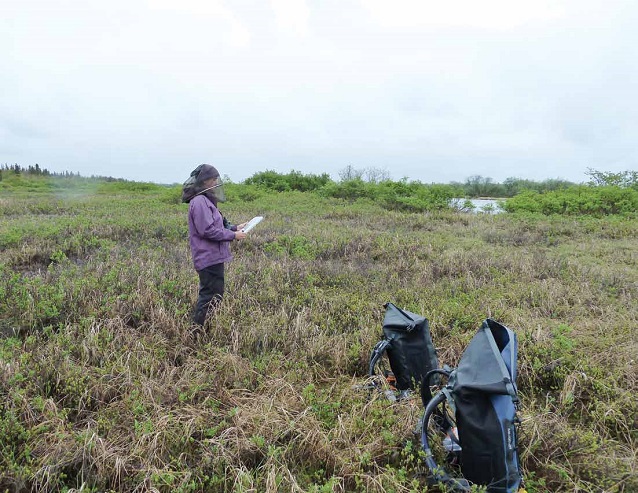
Alaska Natural Heritage Program photograph
Abstract
In order to better understand the status of bird populations and permanently archive bird records, we initiated an effort to enter historical avian occurrence records from the Southwest Alaska Network of the National Park Service into the Avian Knowledge Network (AKN) and its sister database, eBird. In 2010, we archived 8,704 inciden-tal observations for 183 bird species from 82 unique data sources, spanning the time period 1919 to 2004. In 2011, we expanded our effort to include data from 16 standardized surveys conducted between 2006 and 2010, which encompassed 29,575 unique observations for 173 species.
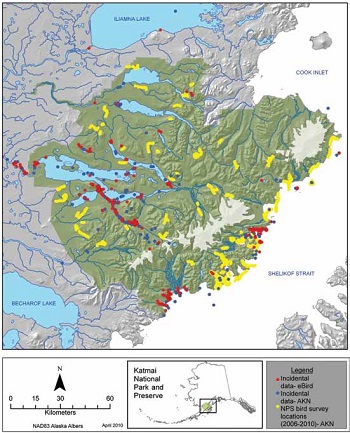
Introduction
Documenting the occurrence of bird species and generating species checklists has become a pastime enjoyed not only by professional ornithologists and naturalists, but also by the general public. The relative ease of identifying birds and their widespread distribution across a variety of habitats lends itself to citizen science data collection. Visitors to Alaska’s national parks are encouraged to submit their wildlife observations for historic record, but to date, there has been no central repository to archive this type of information. Similarly, park researchers and rangers record the occurrence of avian species that are ancillary to their research or observed during river or backcountry patrol trips. These incidental records (not part of a formal bird survey) are often recorded in field notebooks or files, where the in-formation remains unused and at risk of being discarded.
The value of entering historic data into archival databases cannot be overstated. These records help build historic perspective and allow users to look farther back in time when conducting analyses, planning future inven-tories, or looking at changes in species distribution due to changing conditions. The primary mission of the NPS is to conserve unimpaired the natural and cultural resources and values of the national park system for the enjoyment of present and future generations (Marcy 2006). Many parks are currently unable to fully achieve this mission due to a lack of basic knowledge about park resources. A compilation of historic records by recreational and professional bird watchers in combination with standardized bird survey records will help parks realize this mission by providing baseline information for better understanding bird distributions across Alaska park lands.
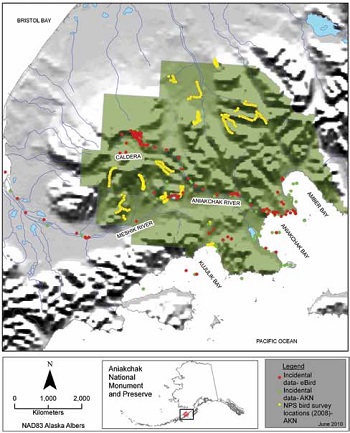
There are currently two national avian archival database efforts in North America: eBird and the Avian Knowledge Network (AKN), both managed by Cornell Lab of Ornithology. These databases were designed to house observational data to as- sess patterns in distribution and dynamics of bird populations across the United States and Canada.
eBird is a real-time, online checklist program that was launched in 2002 by the Cornell Lab of Ornithology and National Audubon Society. Its goal is to maximize the utility and accessibility of the vast numbers of bird observations made each year by recreational and professional bird watchers by sharing these observations with a global community of educa-tors, land managers, ornithologists, and conservation biologists. In 2007, Audubon Alaska launched the Alaska eBird website (www.ebird.org/ak), which is part of the greater eBird database, and is a tool for recording and analyzing bird populations in Alaska.
The Avian Knowledge Network is an international organization of government and non-government institutions focused on understanding the patterns and dynamics of bird populations across the western hemisphere. The goal of the AKN is to organize observational data and provide tools to discover, access, and analyze these data. Over time, AKN will educate the public on the dynamics of bird populations, provide interactive decision-making tools for land managers, and make data available for scientific research. The strength of the AKN lies in its varied and widely diverse bird datasets, ranging from citizen science to surveying and banding datasets.
The objectives of eBird and AKN are similar, but vary somewhat, resulting in slight differences in the data. eBird was designed to capture bird observations from amateur and professional birders and has specific fields for data entry that require an exact date and spatial location. In contrast, AKN is more flexible, and has a variety of fields designed to capture most information that may be recorded along with the bird observation. All eBird data is incorporated into the AKN, but eBird data can also be accessed independently at the eBird web-portal. AKN, in turn, shares data with other larger biodiversity initiatives, such as Ornithological Information System (ORNIS) and Global Biodiversity Information Facility (GBIF), allowing the data to be utilized by an even broader audience for the conserva-tion of avian species at both state and global scales.
The goal of this project was to archive historic and contemporary bird data from Southwest Alaska Network (SWAN) parks into the eBird and AKN databases in order to improve the parks’ and public’s understanding of avian resources. Our specific objectives were to: 1) collect, assemble, and summarize existing incidental observations of the distribution and relative abundance of avian species from visitor observation cards, ranger trip logs, and camp checklists; 2) upload those incidental observations into eBird or AKN; 3) format and upload data from 16 standardized bird surveys conducted in SWAN parks into AKN; and 4) develop a user’s guide for entering avian data into eBird.
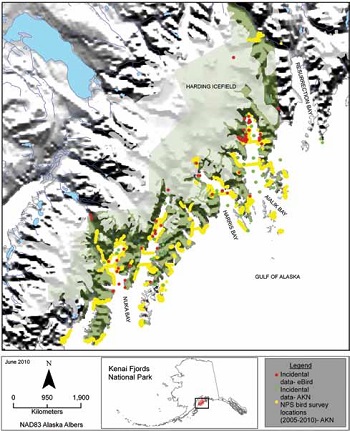
Methods
Incidental bird observations
As part of a previous NPS project, Alaska Natural Heritage Program staff visited each of Alaska’s 16 park offices to compile records of historical bird observations. These data were primarily comprised of bird checklists from established field camps, ranger trip logs, and visitor observation cards and contained a wealth of information on the presence of species and their relative abundances. For this project, incidental observations were extracted from these documents and entered into either eBird or AKN, depending on the type of data included. The initial goal of the project was to enter all observations into eBird; however, since eBird is not designed to handle spatial and temporal uncertainty (which many of the records had), some were entered into the more flexible AKN database. Due to a lack of information often associated with incidental observational data, we only used a subset of the fields available in each database for which we had information across most data sources. Additionally, we developed a user’s guide with step by step instruc-tions on how to enter bird observations into eBird.
Standardized bird survey records
We gathered 16 standardized terrestrial and marine bird datasets from the SWAN parks to archive into AKN. These dataset included landbird surveys in Aniakchak, Katmai, Lake Clark, and Kenai Fjords National Parks and nearshore marine bird surveys in Katmai, Lark Clark, and Kenai Fjords National Parks. An effort was made to crosswalk the fields from the NPS bird survey datasets with fields available in AKN to insure that no information was lost in the archival process.
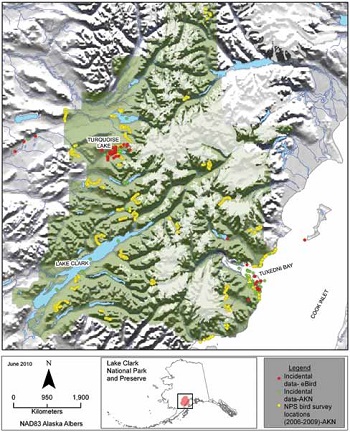
Results
Incidental bird observations
We extracted bird observations from 82 unique sources ranging from ranger trip logs to visitor observa-tion cards. We summarized a total of 8,704 observations for 183 species, of which 69% were archived in AKN and the remaining 31% into eBird. Records ranged from 1919 to 2004 and were clustered in areas that received greater visitation, such as lakes, rivers, bays, and wildlife viewing areas. We entered data on 65 species of conservation concern, as defined by Audubon Alaska, Partners in Flight, Boreal Partners in Flight, Alaska Shorebird Group, U.S. Fish and Wildlife Service, or the Alaska Department of Fish and Game. New park records (species not previously documented within a specific park) were recorded for four species: the red phalarope and semipalmated plover in Katmai and the willow flycatcher and red phalarope in Lake Clark. Additionally, we provided supplementary justification for the presence of 23 species that were previously recorded as probably present, encroaching, or unconfirmed in one of the parks. A user’s guide, available from the Alaska Natural Heritage Program website, was developed to introduce the steps necessary to upload data via the eBird web portal.
Standardized bird survey records
We formatted and uploaded 29,575 records derived from 16 standardized terrestrial and nearshore marine bird survey datasets into AKN. The records were from surveys conducted between 2004 and 2010 and included a total of 173 unique species.
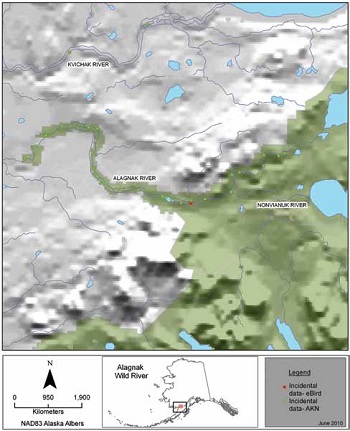
Discussion
Over the past two decades, new technologies have rapidly changed the way we collect, archive, and share scientific data. Twenty years ago, incidental species data collected by park personnel during the field season were recorded in field notebooks. At the end of the field season, these notebooks were filed in a drawer, where many remain today. Similarly, amateur and professional birders have been recording their observations for centuries in life-lists and personal journals. Recent initiatives have made use of the internet as a tool for efficiently gathering, archiving, and distributing bird information to a wide audience. These web portals allow for real-time information exchange, creating new oppor-tunities for rapid integration of bird data into research, monitoring, management, and recreation activities.
We archived 38,279 bird records in and adjacent to SWAN national parks into both databases, providing valuable new information on the distribution and seasonal timing of over 170 avian species. Archival historic information provided justification for adding new species to existing park checklists, as well as validating the status of species which had previously been documented as probably present, encroaching, or unconfirmed. These additions demonstrate the utility and importance of archiving such information. Using incidental observations along with the standardized survey data helps to create a more complete map of distribution and seasonal usage of habitats than using one dataset by itself (Figures 2-6). Ultimately, these data contribute to a baseline of information that helps achieve the overall goal of this project, which is to improve the understanding of the status of bird populations in SWAN parks.
Acknowledgements
This project was funded by the National Park Service’s Southwest Alaska Network Inventory and Monitoring Program. We would like to thank Jen-nifer McGrath and Jennifer Garbutt for assistance with data entry, Bill Thompson (formerly NPS) and Michael Shephard (NPS) for guidance throughout the project, and Brian Sullivan and Marshall Iliff for answering eBird and AKN data entry questions.
References
Marcy, S. 2006. National Park Service Alaska Region science strategy 2006 and beyond: Integrating science to enhance natural resource management in a changing world. Prepared for the National Park Service.
Part of a series of articles titled Alaska Park Science - Volume 11 Issue 2: Science in Southwest Alaska.
Tags
Last updated: June 13, 2016
